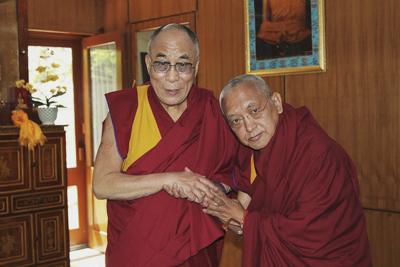Why Tushita Matters
I am very happy to welcome all you Dharma sisters and brothers to this, the thirtieth anniversary of His Holiness the Dalai Lama’s first attendance at Tushita Mahayana Meditation Centre’s annual Dharma Celebration.
The Centre opened in 1979, at the request of my teacher, Lama Yeshe, whose holy name is difficult to express, and soon afterwards, Lama suggested we hold such events each year. The first was in 1981 at The Oberoi. The second, at which we were able to welcome His Holiness, was at the Ashoka.
As I have mentioned before,1 Lama Yeshe wanted to establish a center in India in order to repay the kindness the Indian people have shown Tibetans since the time of the Buddha himself. But a Dharma center has many more benefits than that.
Everybody—believers and non-believers alike—has to practice Dharma because everybody wants to be happy and free from suffering, and Dharma practice is the only way to achieve those goals. And what is the essence of Dharma practice? It’s abandoning negative thoughts and attachment to this life. In other words, it’s completely changing our mind. It means giving up clinging to our body, family, friends and possessions. It means overcoming anger by practicing patience. It means realizing the nature of the mind by perceiving how the “I” that we habitually believe to be real is, in fact, a delusion. It means developing compassion by vanquishing self-cherishing and cherishing others more than ourselves.
But all this does not come naturally. We need to be taught how to practice Dharma, and that’s where the center comes in. Here, qualified teachers explain to students the meaning of the Buddha’s teachings and how to meditate on them and integrate them with their daily lives—because Dharma practice, or meditation, is not just something that is done on a cushion; it is something we have to do every moment of our lives. Dharma is something that has to be lived, not just known.
You will notice that the other word in Tushita’s title is Mahayana. This is a Sanskrit word meaning Great Vehicle and represents the major aspect of the Buddha’s teachings. It is the method by which all sentient beings, including ourselves, are led to enlightenment, the fully awakened state achieved by the Buddha himself. We can be like that. We can lead all beings to buddhahood too. That is why this vehicle is great. There is none greater.
And what is the heart of the Mahayana? What makes your life most beautiful, most satisfying, most fulfilling, most worthwhile, most beneficial and most happy? Here, I’m talking about inner happiness, not just excited, hallucinated happiness. What brings Dharma happiness, the happiness that has completion, the happiness that can continue, increase and develop fully? The happiness that is not suffering, that is worth trying for because it never turns into suffering? The happiness that is not suffering in nature and does not become the suffering of pain? Dharma happiness, the happiness that is worth devoting your life to attaining because it does not interfere with the happiness of others or limit your capacity to benefit others? The happiness that makes your actions only of benefit to others without discrimination? What is it that brings all that happiness? It’s cherishing sentient beings; living your life cherishing sentient beings. Cherish sentient beings first; put enlightenment second.
And it is particularly apt that we think about compassion now, because, as usual, we have the unbelievable good fortune to have as our guest of honor His Holiness. Our fortune is great because when we see His Holiness the Dalai Lama, we are actually seeing the holy body of the Compassion Buddha in human form. His Holiness the Dalai Lama is the actual living Compassion Buddha, so besides hearing his holy speech, even just seeing his holy body is great purification—it makes preparation in our mind for us to be liberated from the oceans of samsaric suffering and plants the seed of enlightenment.
Amongst Dharma centers, Tushita is especially blessed because we have been able to host His Holiness perhaps more than any other Dharma center in the world. And the students of Tushita are exceptionally blessed as well, as you are not only able to meet the Buddha of Compassion regularly, you are also able to nurture the seeds planted by such meetings by receiving teachings and meditation instruction at the center and, in turn, benefit others by sharing the wisdom and compassion you receive there. This is why this center is very important.
Thank you so much for your interest in Tushita and I rejoice in your progress on the path to enlightenment for the sake of all sentient beings.
Notes
1 Becoming Buddha: Wisdom Culture for a Meaningful Life, pp. ix-x. Edited by Renuka Singh. New Delhi: Penguin Ananda, 2011. [Return to text]
























 This collection presents Lama Zopa Rinpoche’s introductions to five of the souvenir booklets produced for Dharma Celebrations held at Tushita Mahayana Meditation Centre, Delhi, India. Edited by Nicholas Ribush.
This collection presents Lama Zopa Rinpoche’s introductions to five of the souvenir booklets produced for Dharma Celebrations held at Tushita Mahayana Meditation Centre, Delhi, India. Edited by Nicholas Ribush.






